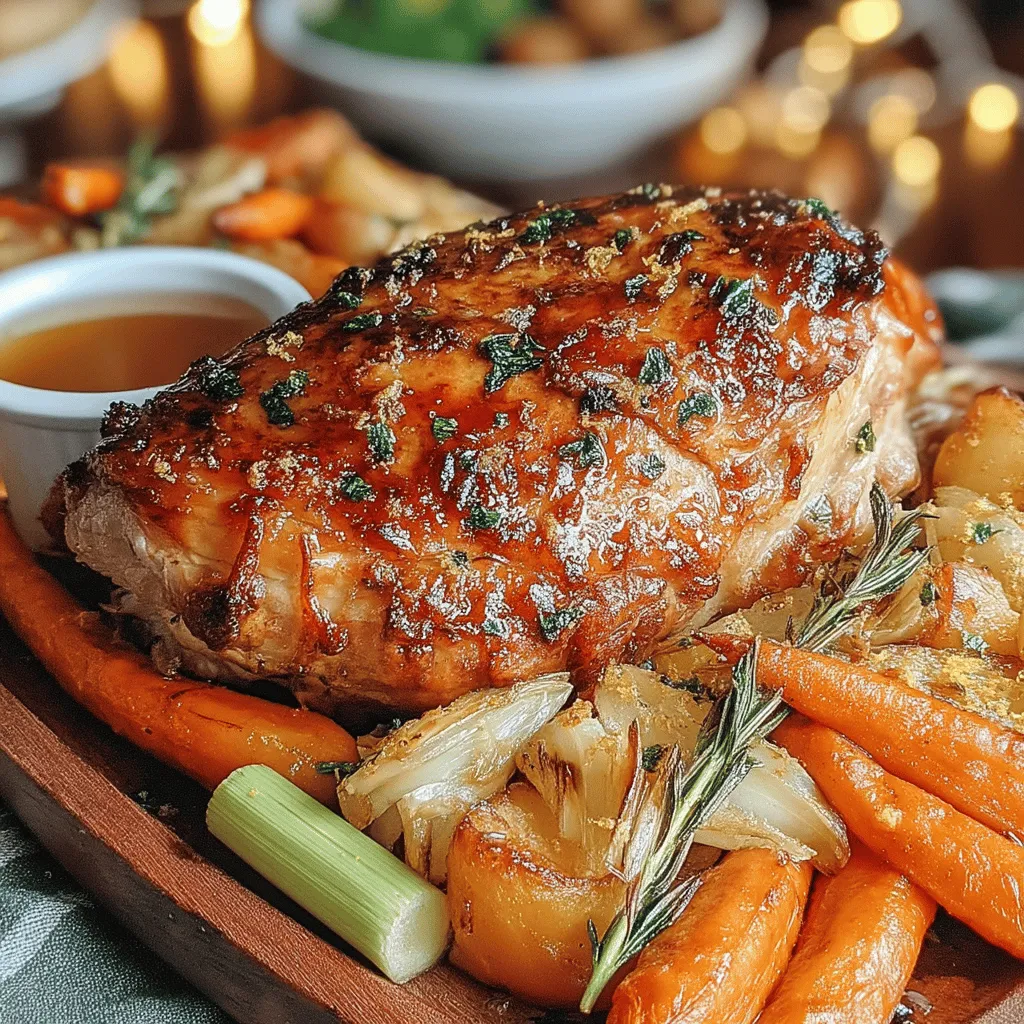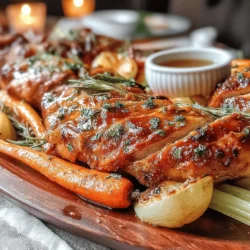Introduction
Turkey has long been a staple of holiday celebrations, often taking center stage at festive feasts. Its rich flavor and tender texture make it a beloved choice for family gatherings, whether it’s Thanksgiving, Christmas, or any special occasion. A succulent, herb-roasted turkey breast not only serves as a delicious main dish but also elevates the entire meal, filling the air with mouthwatering aromas.
Using fresh herbs and quality ingredients is essential for achieving the perfect turkey. This recipe focuses on a bone-in turkey breast, ensuring maximum flavor and moisture retention throughout the cooking process. With the right blend of herbs and a few simple techniques, your holiday turkey will be the talk of the table.
Recipe Overview
– Total Time: 2 hours
– Servings: 8
– Difficulty: Easy
Ingredients
– 1 bone-in turkey breast (about 6-8 pounds)
– 1/2 cup unsalted butter, softened
– 4 cloves garlic, minced
– 2 tablespoons fresh rosemary, chopped
– 2 tablespoons fresh thyme, chopped
– 2 tablespoons fresh sage, chopped
– Zest of 1 lemon
– 1 tablespoon Dijon mustard
– Salt and pepper, to taste
– 1 large onion, quartered
– 3 carrots, cut into chunks
– 2 celery stalks, cut into chunks
– 1 cup chicken broth
– 1/2 cup white wine (optional)

Instructions
1. Preheat the oven to 350°F (175°C).
2. In a bowl, combine the softened butter, garlic, rosemary, thyme, sage, lemon zest, Dijon mustard, salt, and pepper. Mix until smooth and well combined.
3. Pat the turkey breast dry with paper towels. Carefully loosen the skin from the meat using your fingers, creating a pocket for the herb butter.
4. Spread the herb butter mixture evenly under the skin and over the turkey breast, ensuring maximum flavor penetration.
5. Place the quartered onion, carrots, and celery in the bottom of a roasting pan. This will create a flavorful bed for the turkey.
6. Position the turkey breast on top of the vegetables in the roasting pan.
7. Pour the chicken broth and optional white wine around the turkey in the pan.
8. Roast the turkey in the preheated oven for about 1.5 hours, or until the internal temperature reaches 165°F (75°C).
9. Baste the turkey with the pan juices every 30 minutes to keep it moist and flavorful.
10. Once cooked, remove the turkey from the oven and let it rest for at least 20 minutes before carving.
Understanding the Ingredients
Bone-in Turkey Breast
– Choosing a bone-in turkey breast adds flavor and moisture, making it an excellent choice for roasting.
– The bones help to conduct heat evenly, ensuring the meat cooks thoroughly while retaining juiciness.
Herb Butter Mixture
– The combination of garlic, rosemary, thyme, and sage enhances the turkey’s flavor profile, providing a fragrant and savory experience.
– Lemon zest adds brightness, while Dijon mustard contributes a subtle tang.
Vegetables for Roasting
– Onions, carrots, and celery not only flavor the turkey but also create a delicious base for gravy.
– These vegetables help retain moisture during roasting, preventing the turkey from drying out.
Choice of Liquid
– Chicken broth is used to keep the turkey moist, while optional white wine can add depth to the flavor.
– Using these liquids ensures a tender, juicy turkey that is packed with flavor from the very first bite.

Setting Up the Roasting Pan
Creating the perfect roasting environment for your turkey breast begins with the right setup. Start by selecting a sturdy roasting pan that is large enough to accommodate your turkey breast comfortably. Consider using a rack inside the pan to elevate the bird, allowing for even heat circulation and optimal browning.
Importance of a Vegetable Bed for Flavor and Elevation
Laying a bed of vegetables at the bottom of your roasting pan serves two essential purposes. First, it elevates the turkey breast, promoting even cooking and preventing it from sitting in its own juices. Second, the vegetables—such as carrots, onions, and celery—infuse the turkey with additional flavor as they roast, creating a rich base for your gravy.
Pouring in Liquids
Adding liquids to your roasting pan is vital for achieving moist and flavorful turkey. Pour in a combination of broth, wine, or even apple cider to enhance the flavor profile. This liquid not only aids in preventing dryness but also creates a steam effect that keeps the turkey breast juicy throughout the roasting process.
How This Creates a Steam Effect and Enhances Moisture
As the turkey roasts, the liquid in the pan heats up and generates steam, which envelops the turkey breast. This steam helps to maintain moisture levels, ensuring that your turkey is succulent and flavorful. It’s a crucial step that elevates your dish from ordinary to extraordinary.
Roasting Time and Temperature
To achieve a perfectly roasted turkey breast, it’s essential to focus on the right cooking time and temperature. Preheat your oven to 325°F (163°C) for a slow and even roast. A general guideline is to roast the turkey for about 15-20 minutes per pound.
Key Pointers for Cooking the Turkey Breast to Perfection
Use a meat thermometer to check for doneness; the internal temperature should reach 165°F (74°C) in the thickest part of the breast. This ensures that your turkey is safe to eat while remaining moist and tender.
Basting for Perfection
Basting your turkey breast is a crucial step in achieving a beautifully browned and crispy skin.
The Importance of Basting
Basting helps to keep the exterior of the turkey moist while enhancing its flavor and color. Every 30 minutes, spoon the pan juices over the turkey breast to promote an even and appetizing golden hue.
How Basting Affects Skin Texture and Color
The natural fats and herbs in the basting liquid contribute to a rich, crispy skin that is both visually appealing and delicious.
Timing for the Best Results
If the skin begins to brown too quickly, you can tent the turkey breast with aluminum foil to protect it from direct heat while allowing the meat to cook through.
Resting the Turkey
Once your turkey breast has reached the appropriate internal temperature, it’s time to let it rest.
Why Resting is Crucial
Resting allows the juices to redistribute throughout the meat, which results in a juicier turkey when carved.
Recommended Resting Time
Let your turkey breast rest for at least 20-30 minutes before carving. During this time, cover it loosely with foil to retain warmth without steaming the skin.
Carving and Serving Suggestions
Carving the turkey breast correctly can make a significant difference in presentation and serving.
Techniques for Carving the Turkey Breast
Start by placing the turkey breast on a cutting board. Use a sharp knife to slice down along the breastbone, making even, thin slices.
Step-by-Step Guide to Achieving Even Slices
1. Begin by removing the skin if desired.
2. Slice along the breastbone to create two halves.
3. Cut each half into even portions, ensuring to cut against the grain for tenderness.
Presentation Ideas
Arrange the sliced turkey on a platter, garnished with fresh herbs or citrus slices for an appealing presentation.
Pairing Suggestions
Complement your herb-roasted turkey with ideal side dishes and beverages.
Ideal Side Dishes
Consider serving with roasted seasonal vegetables, garlic mashed potatoes, or a tangy cranberry sauce to enhance the meal.
Beverage Pairings
A crisp white wine or a light red can elevate your dining experience, making your holiday gathering even more memorable.
Conclusion
In summary, the key elements that make this herb-roasted turkey breast a holiday favorite include careful preparation, attention to roasting techniques, and thoughtful presentation. This recipe promises to create a centerpiece that not only delights the palate but also enhances the joy of family gatherings. Try this dish for your next holiday feast, and create lasting memories around the table with loved ones.

